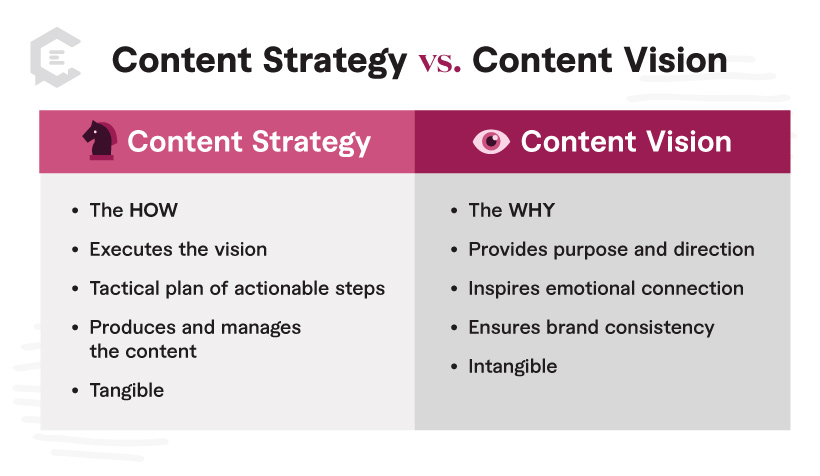If you ask marketers what the most important aspect of a successful content marketing campaign is, you might get a couple of different answers. The top two we hear are either a bold creative vision or a kick-ass content strategy.
At ClearVoice, we’d say that they’re both fundamental aspects of content marketing. And although they’re closely connected, they’re not the same thing. Each has its own unique attributes and functions.
In this article, we’ll discuss content strategy and vision in-depth and clear up any confusion you might have. We’ll review the differences, their interplay, practical implementations, and how you can effectively leverage them within your organization.
Breaking Down the Fundamentals
Before we get into how content strategy and vision interplay, let’s quickly go over each term individually.
Understanding content strategy
Your content strategy is your master plan. It covers the ideation, creation, and distribution of your content and encompasses everything from:
- Identifying target audiences
- Building buyer personas
- Mapping the customer journey with a content matrix
- Determining content themes and topics
- Creating the content
- Choosing content distribution channels
- Setting and measuring KPIs
At its core, a content strategy ensures every piece of content serves a specific purpose that aligns with your broader marketing goals and business objectives.
Recent statistics underscore the importance of a robust content strategy. A Semrush report this past year revealed that only 57 percent of marketers have a documented strategy in place. And only 19 percent consider their strategy advanced.
That’s a pretty serious gap you can take advantage of.
Understanding content vision
While content strategy is the practical plan for creating and managing content, content vision is a belief statement about your brand’s grander narrative.
Put more simply — if your content strategy is the how, your content vision is the why. It’s the guiding star of what your content aims to achieve and reflects your brand’s aspirations, values, and the impact you wish to have on your audience.
Without a content vision, you risk creating content without real meaning. And without meaning, your audience won’t connect with your messaging or brand.
Content Strategy vs. Content Vision
Here are content strategy and content vision in their simplest terms.
Content Vision
- The WHY
- Provides purpose and direction
- Inspires emotional connection
- Ensures brand consistency
- Intangible
Content Strategy
- The HOW
- Executes the vision
- Tactical plan of actionable steps
- Produces and manages the content
- Tangible
The Interplay of Strategy and Vision
Together, your content strategy and content vision ensure every piece of content serves immediate business objectives while also resonating with your brand’s long-term mission.
A clear and compelling content vision anchors your content strategy. It gives purpose and value to the content you create and ensures every marketing effort resonates with your brand’s core values. Your content strategy puts your content vision into operation, turning it into an actionable plan of practical steps.
Challenges and solutions in aligning both aspects
As you work to align your content strategy and content vision, here are some of the most common challenges you’ll encounter, along with best practices for solving them.
Challenge 1: Maintaining Consistency Between Vision and Strategy
Solution: Develop a Unified Brand Message
Create strong brand and editorial guidelines that encapsulate your content vision. Ensure that any content created within your strategy aligns with it at every step. Also, regularly review your strategy and vision to ensure they stay in sync.
If you’re struggling with where to start, here’s some visual inspiration from top brands.
Challenge 2: Communicating Your Content Vision Across Departments
Solution: Foster Cross-Departmental Collaboration
Your content vision isn’t limited to the marketing department. Keep an eye out for silos developing within your company. They can lead to miscommunication, missed opportunities, and a lack of consistency.
Keep communication lines open by scheduling regular meetings to share updates and address issues. Offer cross-training opportunities and incorporate digital collaboration tools. And if you really want to break down your content silos, read our in-depth guide.
Bonus tip: Creating a strong content marketing culture within your organization doesn’t hurt either!
Challenge 3: Adapting to Market Changes Without Losing Vision
Solution: Flexible Strategy, Steadfast Vision
Keep your content vision consistent and your content strategy malleable enough to respond to changing market trends, tech developments, and audience behavior. Your marketing goals may adapt over time. In fact, we’d argue that regular goal evaluation and refinement are essential. Don’t be afraid to adjust your strategy; just ensure those adjustments stay aligned with the core of your content vision.
Case Study: Airbnb’s “Belong Anywhere” campaign
Airbnb’s “Belong Anywhere” campaign exemplifies how a powerful content vision combined with a strong content strategy can create a marketing phenomenon.
Airbnb’s Content Vision:
Airbnb’s vision was to transform the concept of travel accommodation from a transactional experience into an emotionally rich, connective one. They capitalized on the notion of “belonging.” The “Belong Anywhere” campaign was born out of the idea that travel should be about living in a place, not just staying there. It aimed to resonate deeply with travelers seeking authentic experiences, evoking feelings of belonging and community.
Strategic Implementation:
To bring this vision to life, Airbnb’s content strategy involved several key elements:
- Storytelling: Airbnb leveraged real stories from hosts and guests to showcase the unique experiences and connections formed across the globe from using their service.
- Community-Centric Content: Airbnb focused on creating content that reflected the voices and experiences of its community through local travel tips from hosts and user-generated content on social media
- Global Reach, Local Touch: Their strategy was global in reach but local in execution. They tailored their content to reflect each place’s local culture and ethos, emphasizing the idea of experiencing destinations as locals do.
The Impact:
The “Belong Anywhere” campaign was a resounding success, not only in terms of brand awareness but also in forging an emotional bond with its audience. It redefined Airbnb’s brand identity, positioning it as a leader in offering unique travel experiences. It’s still recognized as category-defining and helped propel Airbnb’s valuation to $29 billion above their closest competitor in less than four years.
Practical Implementation
A quick note before we dive into this section: before you create your strategy or vision, take a step back and assess the current state of your company. Be honest about where you are and where you want to be. Those two markers will guide you to begin creating your strategy and vision.
Crafting a clear content vision
Crafting a content vision is like creating any critical strategy within your company. It requires active involvement from your team and deliberate, collective efforts to shape a vision that genuinely reflects the essence of your organization.
Remember, this is the “why,” not the “how.” Use that perspective to ground your team and refocus efforts if they start to drift away from that mentality.
Let’s break it down:
- Define your brand’s core values: Start by articulating what your brand stands for. What’s the company’s overall mission? What are you trying to solve? What story is your brand trying to tell?
- Identify the “why”: After fleshing out what your brand stands for, hone in on the why behind it all. Discuss why your organization exists, why it matters to your audience, and why your content is valuable. This is where you find your content strategy’s emotional and philosophical core.
- Analyze your audience: You must understand who you’re creating content for. Dive into your audience’s needs and pain points. Consider how your content can connect with them and address these aspects.
- Create a vision statement: Use the insights from the previous steps to craft a clear, concise vision statement. Your vision statement should be aspirational and reflective of how you want your audience to perceive your brand. Who do you want to become?
- Align with business goals: Ensure your content vision aligns with broader business objectives before implementing it. It should support and enhance your company’s overall goals.
- Develop your guidelines: Create guidelines that align with your vision and ensure brand consistency in tone, style, and messaging across all your content creation.
- Review and adjust (as needed): Ideally, your content vision focuses on the long run. But, revisit your content vision periodically to ensure it remains relevant and aligned with any changes in your company’s strategy or market dynamics.
Developing a content strategy
Here at ClearVoice, we always insist on having a clear and effective strategy before creating our content. Here’s a step-by-step guide on how to create yours:
- Define your objectives: Start by setting clear, measurable marketing goals that align with your content vision and overall business objectives. What do you want to achieve with your content? These goals will provide the framework for your content decision-making.
- Develop your buyer personas: You’ve probably already gathered information on your audience. But to build the right audience, you have to dive deep. Use comprehensive audience analysis tools and techniques to create buyer personas that will help you tailor your upcoming content with precision.
- Conduct a content audit: Before creating new content pieces, review your existing content. What’s working, and what isn’t? Identify any gaps or opportunities for refreshes that align with the new content strategy.
- Choose your content distribution channels: Determine where your audience spends their time and where your content can impact most. What platforms are they using? Tools like Google Analytics and Brandwatch can be game-changers in this department.
- Develop a content calendar: Create a content calendar in six simple steps to keep your content production organized and ensure consistent content delivery.
- Create and distribute content: You finally get to create the content! Once you do, distribute it through your chosen channels. Ensure it’s high-quality.
- Measure and optimize: Use analytics to measure the performance of your content. Pick specific KPIs to monitor and continuously refine your strategy based on these insights.
Harmonizing Your Content Strategy with Vision
We must admit there’s no better feeling than watching content aspirations become reality. That’s why we’ve partnered with thousands of marketers for over a decade to create top-notch content that drives success.
If you’re ready to unlock the combined power of your strategy and vision to reach new heights for your brand, ClearVoice has your back.
Talk to us today, and we’ll get you started.












